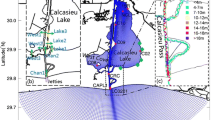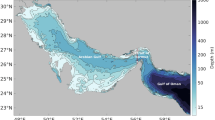Summary
The paper gives a descriptive study of salt propagation in the area between Fehmarn Belt and Darσ Sill which is part of the transition region between the Baltic and the North Sea. A synthesis of observations and numerical modelling is used to elucidate the dynamics of currents and salinity patterns in response to the external forcing.
Quasi-synoptic pictures of the dynamic patterns were recorded during two cruises (autumn 1994 and summer 1995) by CTD sections and ADCP tracks with a towed instrument. Hindcast simulations with a numerical circulation model showed that the field data are well reproduced by the model, but that the quasi-synoptic observations are subject to undersampling. This is due to the fact that the time scales of the variability are smaller than the duration of each of the oceanographic surveys.
The general pattern of salt propagation during inflow is governed by a 10 to 20 km wide tongue of saline water which is transported towards the Darσ Sill. During outflow the tongue withdraws and a strong salinity gradient builds up in the Fehmarn Belt. Mesoscale processes, such as e.g. coastal up- and downwelling and eddy formation, which are affected by the different stratification in autumn and summer, play an important role in shaping the salinity patterns.
Zusammenfassung
Mit Hilfe einer Synthese von Beobachtung und Modellierung wird die Ausbreitung des Salzwassers zwischen Fehmarn Belt und Darσer Schwelle untersucht, um die Dynamik der Verteilungsmuster von Strömungen und Salzgehalt in Reaktion auf die externen Antriebe genauer zu verstehen.
Quasi-synoptische ozeanographische Aufnahmen im Herbst 1994 und im Sommer 1995-mit CTD und geschlepptem ADCP wurden mit Simulationen eines numerischen Zirkulationsmodells kombiniert. Das Modell konnte die Messungen gut reproduzieren, wenn die Zeitpunkte der einzelnen Schnitte genau berücksichtigt werden. Ansonsten sind die beobachteten, quasi-synoptischen Aufnahmen durch Fehlabtastung (undersampling) verzerrt.
Das allgemeine Muster der Salzausbreitung in Einstromsituationen ist durch eine 10 bis 20 km breite Zunge salzreichen Wassers charakterisiert, die in Richtung der Darσer Schwelle transportiert wird. Bei Ausstrom zieht sich diese Zunge zurück und im Fehmarn Belt baut sich ein Salzgradient auf. Mesoskalige Prozesse, wie Ekman-Auftrieb, Küstenstrahlströme und Wirbel, die durch die unterschiedliche Schichtung in Herbst und Sommer beeinfluσt werden, spielen eine wichtige Rolle für die Herausbildung der Salzverteilungsmuster.
Similar content being viewed by others
References
Bryan, K., 1969: A numerical method for the study of the circulation of the world ocean.J. Comp. Phys.,3, 347–376.
Fennel, W., T. Seifert, andB. Kayser, 1991: Rossby radii and phase speeds in the Baltic Sea.Continental Shelf Research,11, 23–36.
Fennel, W., andM. Sturm, 1992: Dynamics of the western Baltic.Journal of Marine Systems,3, 183–205.
Fennel, W., andT. Seifert, 1995: Kelvin wave controlled upwelling in the western Baltic.Journal of Marine Systems,6, 289–300.
Huber, K., E. Kleine, H.-U. Lass, andW. Matthäus, 1994: The major Baltic inflow in January 1993 in measurements and modeling results.Dt. Hydrogr. Z.,46, 103–114.
Jensen, H. R., 1997: DYNOCS Technical Report, Regional Model, DHI, Copenhagen.
Klllworth, P. D., D. Stainforth, D. J. Webb, andS. Paterson, 1991: The development of a free surface Bryan-Cox-Semtner model.J. Phys. Oceanogr.,21, 1333–1348.
Krauss, W., andB. Brügge, 1991: Wind-produced water exchange between the deep basins of the Baltic Sea.Journal of Physical Oceanography,21, 373–384.
Lange, W., 1975: Zu den Ursachen langperiodischer Strömungsänderungen im Fehmarn Belt.Kieler Meeresforschungen,31, 65–81.
Lass, H. U., andR. Schwabe, 1990: An analysis of the salt water inflow into the Baltic in 1975 to 1975.Dt. Hydrogr. Z.,43, 97–125.
Lass, H. U., R. Schwabe, W. Matthäus, andE. Francke, 1987: On the dynamics of water exchange between Baltic and North Sea.Beitr. Meereskunde,56, 27–49.
Lehmann, A., 1995: A three-dimensional eddy resolving model of the Baltic Sea.Tellus,47A, 1013–1031.
Matthäus, W., E. Francke, H. U. Lass, undR. Schwabe, 1982: Untersuchung der Wasseraustauschprozesse im Bereich der Darσer Schwelle.Beitr. Meereskunde,47, 31–50.
Matthäus, W., H. U. Lass, E. Francke, undR. Schwabe, 1983: Zur Veränderlichkeit des Volumen- und Salz-transportes über die Darσer Schwelle.Gerlands Beitr. Geophys.,92, 407–420.
Matthäus, W., andH. Franck, 1992: Characteristics of major Baltic inflows — a statistical analysis.Continental Shelf Research,12, 1375–1400.
Matthäus, W., andH.-U. Lass, 1995: The recent salt water inflow into the Baltic Sea.Journal of Physical Oceanography,25, 280–286.
Mutzke, A., 1998: Open boundary condition in the GFDL-model with free surface.Ocean Modelling,116, 2–6.
Pacanowski, R. C., andS. G. H. Philander, 1981: Parameterization of the vertical mixing in numerical models of the tropical ocean.Journal of Physical Oceanography,11, 1443–1451.
Siegel, H., M. Gerth, R. Rudloff, andG. Tschersich, 1994: Dynamical features in the western Baltic Sea investigated using NOAA-AVHRR data.Dt. Hydrogr. Z.,46, 191–209.
Stigebrandt, A., 1983: A model for the exchange of water and salt between the Baltic and the Skagerrak.Journal of Physical Oceanography,13, 411–427.
Stigebrandt, A., 1984: Analysis of an 89-year-long sea level record from the Kattegat with special reference to the barotropically driven water exchange between the Baltic and the North Sea.Tellus,36A, 401–408.
Sturm, M., R. Helm, undW. Fennel, 1988: Mesoskale Wirbel in der westlichen Ostsee.Beitr. Meereskunde,58, 73–75.
Weiergang, J. andM. Jønsson, 1996: DYNOCS Technical Data Report, Copenhagen.
Wyrtki, K., 1954: Der groσe Salzeinbruch im November und Dezember 1951.Kieler Meeresforschung,10, 10–19.
Author information
Authors and Affiliations
Rights and permissions
About this article
Cite this article
Schmidt, M., Seifert, T., Lass, H.U. et al. Patterns of salt propagation in the Southwestern Baltic Sea. Deutsche Hydrographische Zeitschrift 50, 345–364 (1998). https://doi.org/10.1007/BF02764229
Received:
Accepted:
Published:
Issue Date:
DOI: https://doi.org/10.1007/BF02764229




